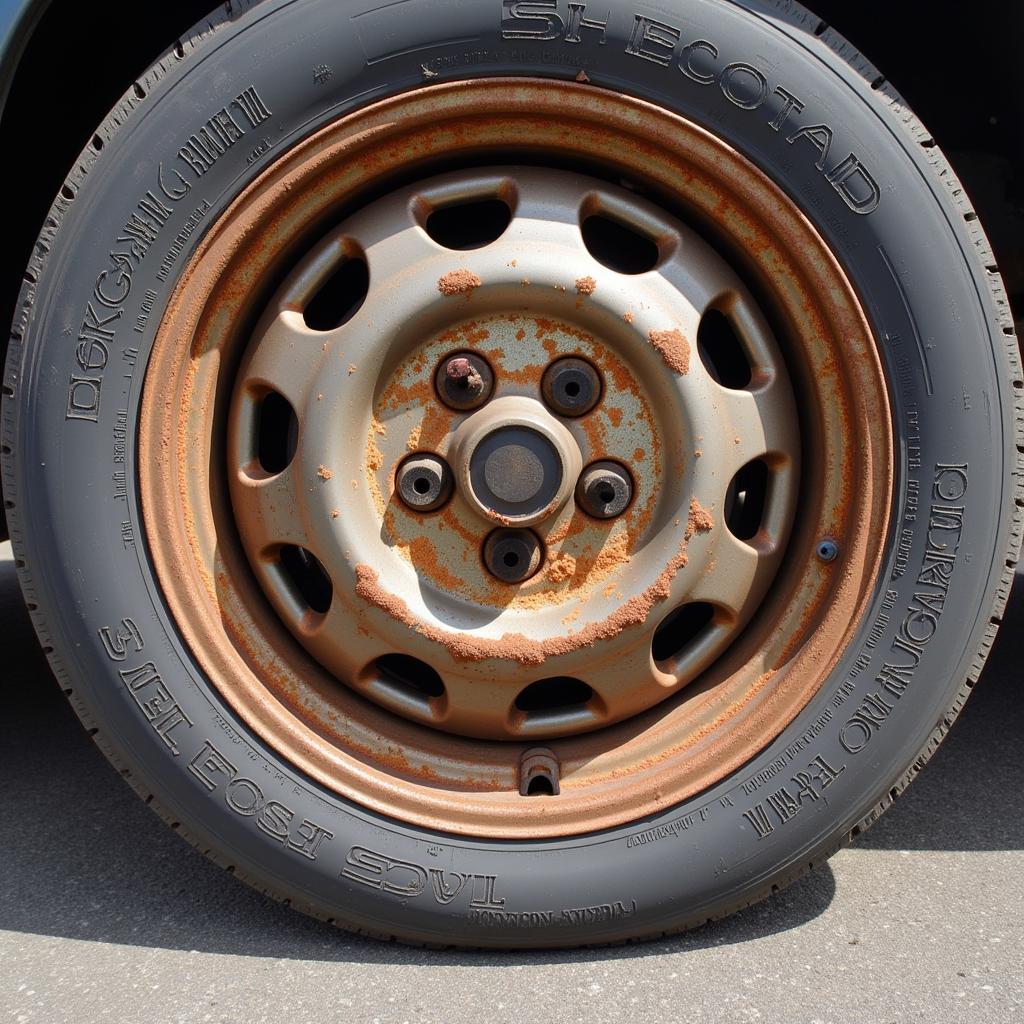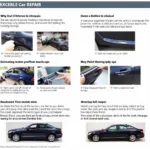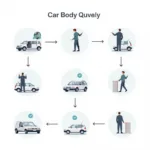Car paint rust repair is crucial for maintaining your vehicle’s appearance and structural integrity. Rust, if left untreated, can spread quickly, compromising the metal and leading to costly repairs. This guide provides a comprehensive overview of car paint rust repair, from identifying the problem to preventing future occurrences.
One of the first steps in addressing rust is understanding its cause. Rust forms when iron or steel alloys are exposed to moisture and oxygen, a chemical reaction known as oxidation. This process is accelerated by road salt, acidic rain, and coastal environments. Addressing rust early can save you significant time and money in the long run. Learn more about specialized rust repair in cumberland md car rust paint repair.
Identifying Rust on Your Car’s Paint
Rust often appears as small, reddish-brown spots or blisters on the car’s paint surface. It can also manifest as flaking paint, bubbling, or even holes in the metal. Common areas susceptible to rust include wheel wells, rocker panels, door bottoms, and areas around trim and moldings. Regular inspection, especially after winter or exposure to harsh weather, is key to early detection.
 Identifying Rust on Car Wheel Well
Identifying Rust on Car Wheel Well
DIY Car Paint Rust Repair: A Step-by-Step Guide
For minor rust spots, a DIY repair might be feasible. This involves sanding the rusted area, applying a rust converter, priming, and repainting. It’s crucial to remove all the rust before proceeding with any repairs. Check out our guide on how to repair and paint rust on car for a detailed walkthrough.
Sanding and Preparing the Rusted Area
Use sandpaper to remove the rust and any loose paint surrounding the affected area. Start with coarser grit and gradually move to finer grit for a smooth finish. Clean the area thoroughly after sanding to remove any dust or debris.
Applying Rust Converter and Primer
Apply a rust converter to the affected area, following the manufacturer’s instructions. This chemically converts the rust into a stable compound. Once the rust converter has dried, apply a primer designed for metal to protect the surface and provide a good base for the new paint.
Repainting the Repaired Area
Once the primer is dry, apply matching automotive paint to the repaired area. Multiple thin coats are generally recommended for a better finish. A clear coat can be applied for added protection and shine.
Professional Car Paint Rust Repair
For more extensive rust damage, professional repair is highly recommended. Professionals have the expertise, tools, and experience to handle complex rust repairs, ensuring a lasting and aesthetically pleasing result. They can also address underlying structural issues that might be contributing to the rust. Consider professional help if you’re dealing with significant rust or are unsure about tackling the repair yourself. Explore more about specific rust spot repairs in repair rust spots car paint.
Preventing Car Paint Rust
Preventing rust is always better than dealing with it after it occurs. Regularly washing and waxing your car helps protect the paint and prevent moisture from reaching the metal. Applying a rust inhibitor, especially in areas prone to rust, can also offer additional protection. Promptly addressing paint chips and scratches prevents rust from forming in these vulnerable areas. For more tips on repairing paint chips with rust, check out how to repair paint chips with rust on a car.
Regular Car Washes and Waxing
Washing your car regularly removes dirt, salt, and other contaminants that can contribute to rust formation. Waxing provides an additional layer of protection, creating a barrier against moisture.
Applying Rust Inhibitor
Rust inhibitors are available in spray or brush-on form and can be applied to the undercarriage and other vulnerable areas to prevent rust formation.
Addressing Paint Chips and Scratches Promptly
Paint chips and scratches expose the underlying metal to the elements, making them susceptible to rust. Addressing these minor imperfections promptly can prevent rust from taking hold. You can find more information regarding rusted paint repair at car rusted paint repair.
Conclusion
Car paint rust repair is essential for preserving your vehicle’s appearance and value. By understanding the causes of rust, taking preventative measures, and addressing rust promptly, you can keep your car looking its best and avoid costly repairs down the line.
FAQ
- What causes car paint rust? Exposure to moisture and oxygen causes oxidation, leading to rust.
- How can I prevent car paint rust? Regular washing, waxing, and applying rust inhibitor can help.
- Can I repair car paint rust myself? Minor rust spots can be repaired with DIY methods, but extensive damage requires professional attention.
- What are the signs of car paint rust? Reddish-brown spots, flaking paint, bubbling, and holes in the metal are common signs.
- Where is rust most likely to occur on a car? Wheel wells, rocker panels, door bottoms, and areas around trim are common rust locations.
- What tools do I need for DIY car paint rust repair? Sandpaper, rust converter, primer, paint, and clear coat are typically required.
- How much does professional car paint rust repair cost? The cost varies depending on the extent of the damage.
Need help? Contact us via WhatsApp: +1(641)206-8880, Email: [email protected]. We have a 24/7 customer support team.


